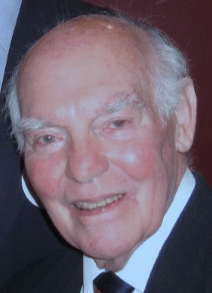Harold Charles Richards
Harold Charles Richards (12 October 1925 – 2 June 2014) was an Australian civil engineer who co-founded the consulting engineering firm Hardcastle & Richards.[1]
Harold Charles Richards | |
|---|---|
 | |
| Born | 17 November 1925 Melbourne, Victoria |
| Died | 2 June 2014 (aged 88) |
| Nationality | Australian |
| Education | Royal Melbourne Institute of Technology |
| Occupation | Civil engineer |
| Employer | Hardcastle & Richards |
| Known for | Contributions to engineering education, philanthropy |
| Spouse(s) | Joyce |
| Children | Anthony, Margaret, Noel, Rosalie, Naomi |
Career
Harold Richards studied engineering at the Royal Melbourne Institute of Technology.[2] In 1951, he worked in the Design Section of Johns and Waygood, which was responsible for many of Australia's post-war infrastructure developments.[3] In 1952, the co-founded Hardcastle & Richards with business partner Roy Hardcastle, as a result of winning the design competition for the Olympic Stadium for the 1956 Melbourne Olympic Games. However, a change in government caused the cancellation of the project. The firm expanded to have offices in Melbourne, Perth, Sydney, Brisbane and Broken Hill.[4] The firm was involved in many civil engineering projects, including the King Street Bridge over the Yarra River.[5] In 1962, Hardcastle & Richards were invited by the School of Engineering at the University of Melbourne to participate in guiding students’ final year design projects.[3] These projects were based on actual projects in which the firm had been involved. This association with engineering education lasted five decades.
Other positions held:[1]
- Chairman of the Victorian Institute of Marine Science, 1994-1997
- Chairman of the Marine and Freshwater Research Institute, 1997-1998
- Member of the Board of Management, Greenvale Centre and Mount Royal Hospital, 1990-1991
- President Emeritus, Broadmeadows College of TAFE, 1989-1993
- Elder, St John's Uniting Church in Australia, 1977-2014
- Councillor, Shire of Bulla, 1965-1985
- President, Shire of Bulla, 1972
- President of the Association of Consulting Engineers Australia, 1977-1980
- Vice-President of the Australian College of Professions, 1975
- National Vice-President, Institution of Engineers Australia, 1973-1975
- Member of the National Capital Planning Committee, 1973-1978
- Member of Board of Management, North West Hospital, Melbourne, 1991-1995
Philanthropy
For almost 50 years, Hardcastle & Richards were major donors to the School of Engineering at the University of Melbourne[2] and to RMIT University. In 1979, a bronze relief by artist Michael Meszaros, entitled Compression and Tension was presented to the Department of Civil Engineering to mark the 25th anniversary of the founding of the firm.[6] Richards was the founder of the Rotary Club of Carlton in 1985 and its Charter President.[7]
Honours
- Member of the Order of Australia, 1980, for service to technical education[8]
- Honorary Associate Professor, Department of Civil and Environmental Engineering, University of Melbourne[3]
- Elected Fellow, Institution of Engineers Australia[1]
- Paul Harris Fellow, Rotary International, 1995[1]
- Honorary Life Member, Rotary Club of Carlton, 2013[9]
References
- Who’s Who in Australia 2009. North Melbourne, Victoria: Crown Content.
- Melbourne School of Engineering. "Stories from the Melbourne School of Engineering". Retrieved 22 April 2019.
- University of Melbourne. "Vale Associate Professor Harold Richards AM". Retrieved 22 April 2019.
- Encyclopedia of Australian Science. "Hardcastle & Richards (1952-?)". Retrieved 22 April 2019.
- Engineers Australia Victorian Division. "Discover Engineering Heritage: Central Melbourne" (PDF). Retrieved 22 April 2019.
- Graduate Union of the University of Melbourne. "The Melbourne Graduate July 2013". Retrieved 22 April 2019.
- Graduate Union of the University of Melbourne. "The Melbourne Graduate July 2013". Retrieved 22 April 2019.
- Commonwealth of Australia. "Commonwealth of Australia Gazette No. S130" (PDF). Retrieved 25 April 2019.
- Rotary Club of Carlton. "Presentation of Honorary Life Membership". Retrieved 22 April 2019.